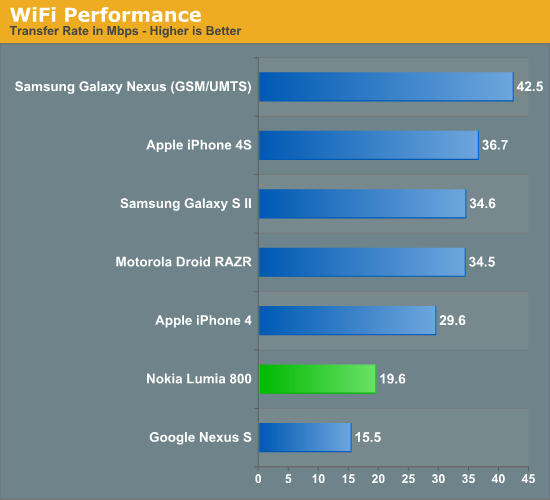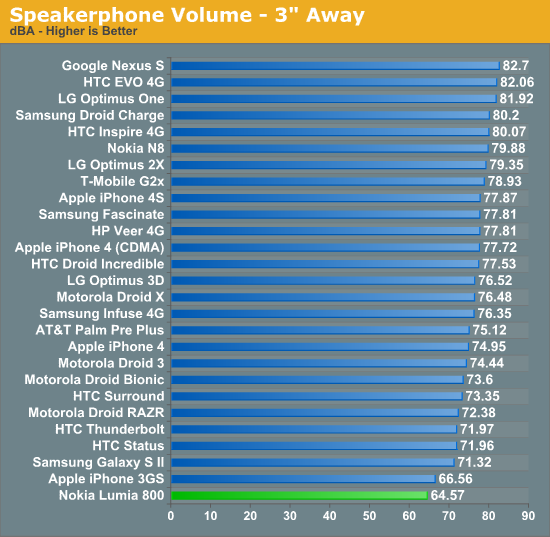Nokia Lumia 800 Review - Nokia's Brave New Foray into WP7
by Brian Klug on January 4, 2012 7:00 AM EST- Posted in
- Smartphones
- Nokia
- windows phone 7
- Mobile
- WP7
- Lumia
- Lumia 800
Cellular
Cellular on the Lumia 800 is supplied courtesy the MSM8255’s onboard baseband. Like all the Qualcomm S2 parts, this means GSM/EDGE/WCDMA with HSPA+. The Lumia 800 also takes a microSIM as noted earlier, and I tested on AT&T in my market. There are actually two Lumia 800 variants, each with different WCDMA bands - we were sampled the European variant which worked with AT&T’s PCS 1900 MHz WCDMA in my market. The Nokia Lumia 800 Specifications page is a bit misleading since it would have you believe that there’s only one variant with quad-band WCDMA when there are actually two different tri-band WCDMA devices.
| Nokia Lumia 800 - Network Support | |
| GSM/EDGE Support | 850 / 900 / 1800 / 1900 MHz |
| RM-801 (Europe) WCDMA Support | 900 / 1900 / 2100 MHz |
| RM-819 (USA) WCDMA Support | 850 / 1900 / 2100 MHz |
| Baseband Hardware | QCT MDM8255 w/QTR8200 |
| HSPA Speeds | HSDPA 14.4 (Cat.10) / HSUPA 5.76 (Cat.6) |
I couldn’t do my usual stats collection and histogram on the Lumia 800 since there’s no way to export that data from any of the speed test applications on Windows Phone. However, I did run some tests and see acceptable levels of throughput out of the device.
.jpg)
.jpg)
Some speedtests taken with BandWidth on WP7
WiFi
WiFi and Bluetooth 2.1 EDR on the Lumia 800 is supplied courtesy of a Broadcom BCM4329 combo chip which we’ve seen numerous times before in a number of different smartphones. Though newer devices are starting to ship BCM4330, I wager that WP7.5 includes drivers for just BCM4329 (which a huge majority of Windows Phones include) and BCM4325 (Venue Pro). On the Lumia 800, this means single spatial stream 802.11b/g/n connectivity only on the 2.4 GHz band.

Regardless, WiFi range on the Lumia 800 is totally par for the current generation of devices. In addition, WP7.5 continues to do a great job at deciding when to hand off and back onto WiFi when leaving the coverage radius of your house. It’s the small things like these that (to me at least) really demarcate the previous generation of smartphone OSes from the new breed. Unfortunately, in our throughput test which consists of loading a 100 MB PDF hosted locally on an 802.11n network, the Lumia 800 isn’t quite up to the speed of other BCM4329 devices. I’d wager this has more to do with the OS than anything else, though running network throughput applications on the Lumia 800 also gave a similar number to our normal PDF download test.
I should also note that WP7.5 also includes the ability to connect to WiFi APs that don’t broadcast their SSID. There’s a tab under Advanced in WiFi that now allows you to enter all that information and connect away, this wasn’t possible until Mango.
Speakerphone
In calls, the speakerphone on the Lumia 800 is honestly a bit too quiet, and our testing with a sound level data logger backs this up. Even at absolute maximum (where we test, of course) I found the sound level inadequate while using Nokia Drive or placing calls. It isn’t so much the position of the speaker at the bottom that’s a problem (in fact this is a good place to locate it), it’s just not loud enough.

Hopefully, this can be addressed with some software tweaking of the gains for speakerphone volume.
I also recorded some call quality test samples on the Lumia 800. The smartphone also does have the multiple microphone system for common mode noise rejection, though I'm not certain whose IP is being leveraged - perhaps Qualcomm's Fluence?
Noise rejection on the Lumia 800 is very good at all but the most extreme volume levels. Still, there are handsets that can completely reject the ambient noise that you hear at our maximum volume level. Unless you're in an absurdly loud environment, chances are the Lumia 800 will do a good job rejecting noise common between the two microphone system.
GPS
The Lumia 800 uses the GPS/GLONASS (GNSS) system onboard MSM8255 which we’ve seen numerous times before. Though WP7 doesn’t have API access to NMEA data so we can see SNR from individual satellites, the Lumia 800 does seem to get a GPS lock speedily enough even in some tough environments. In both the maps application and Nokia Drive I had no issues getting a GPS lock in under a 5 seconds keeping the lock for the duration of navigation.










120 Comments
View All Comments
crispbp04 - Wednesday, January 4, 2012 - link
Steve Jobs already proved that consumers are idiots. the minority of consumers want android. The majority want something that works, is pretty, and is fun to use. This is the definition of Windows Phone 7. Elop is saving Nokia by betting the farm on Microsoft. Who cares if he has to alienate blind android fanboys such as yourself.steven75 - Wednesday, January 4, 2012 - link
The majority of users also want wide access to the software everyone else has, and WP7 still fails hard on this.crispbp04 - Wednesday, January 4, 2012 - link
cite a specific example of a piece of software you use on android or iOS that isn't on the WP7 marketplace.Thermogenic - Wednesday, January 4, 2012 - link
PayPal app. The mobile website is not nearly as nice as the iPhone or Android apps.doobydoo - Saturday, January 7, 2012 - link
Sky Sports app. Only available on iPhone / iPad.Iketh - Wednesday, January 4, 2012 - link
I have all 3 phone OS's in my home. My wife uses the Android and she hates it, as do I. (She started with WP7 and switched because she didn't like it either, but wishes she had it back now.) I'm using the WP7, but it was a hard decision to leave iOS, mainly because of the superior map app. But the WP7's audio and video quality is far superior to iOS. You're too restricted on the .264 profile allowed on iOS for whatever reason.Other than that, as far as software selection available, everyone can find anything they need on all 3 devices. The software selection on WP7 is already robust, and it's only the beginning.
Imagine when x86 hardware meets Windows Phone. I can't wait...
Mitch89 - Friday, January 6, 2012 - link
When you say audio and video quality are you referring to playback? You can easily use apps like AV Player to playback different formats. High def h.264 looks great on the iPhone 4S in AV Player, not to mention it supports a variety of other formats.sprockkets - Wednesday, January 4, 2012 - link
Yeah, that's why Android has the lion's share of the market, cause "nobody" wants it.Right.
Nfarce - Wednesday, January 4, 2012 - link
Exactly, sprockkets. Let these people talk themselves into whatever they want. It's a free market. And nothing makes me laugh better than an Apple or Winphone fangirl calling Droid users fanbois. LMAO. Not only are Droid phones at the top of the sales charts, they are at the top of the performance charts overall (as this article shows). Just let them lie themselves to sleep at night and move on.doobydoo - Saturday, January 7, 2012 - link
The iPhone 4S is at the top of the pile as far as performance goes. That is reality.Secondly - you both miss the point. People tend to only buy Android over iPhone because it's cheaper. If they were both the same price, you could bet that Android would not be the biggest. Of course, Apple has found the sweet spot in pricing so wouldn't want to change.
Thirdly - Android is only bigger because there are more handsets available, from numerous manufacturers, so no one company actually benefits as much as Apple does. Similarly, no one handset is as popular or in demand as the iPhone 4S right now.
Finally - there are so so many VERY cheap and totally incomparable and retro phones which run old and rubbish hardware with old and rubbish versions of Android which bolster the statistics and provide a false impression.